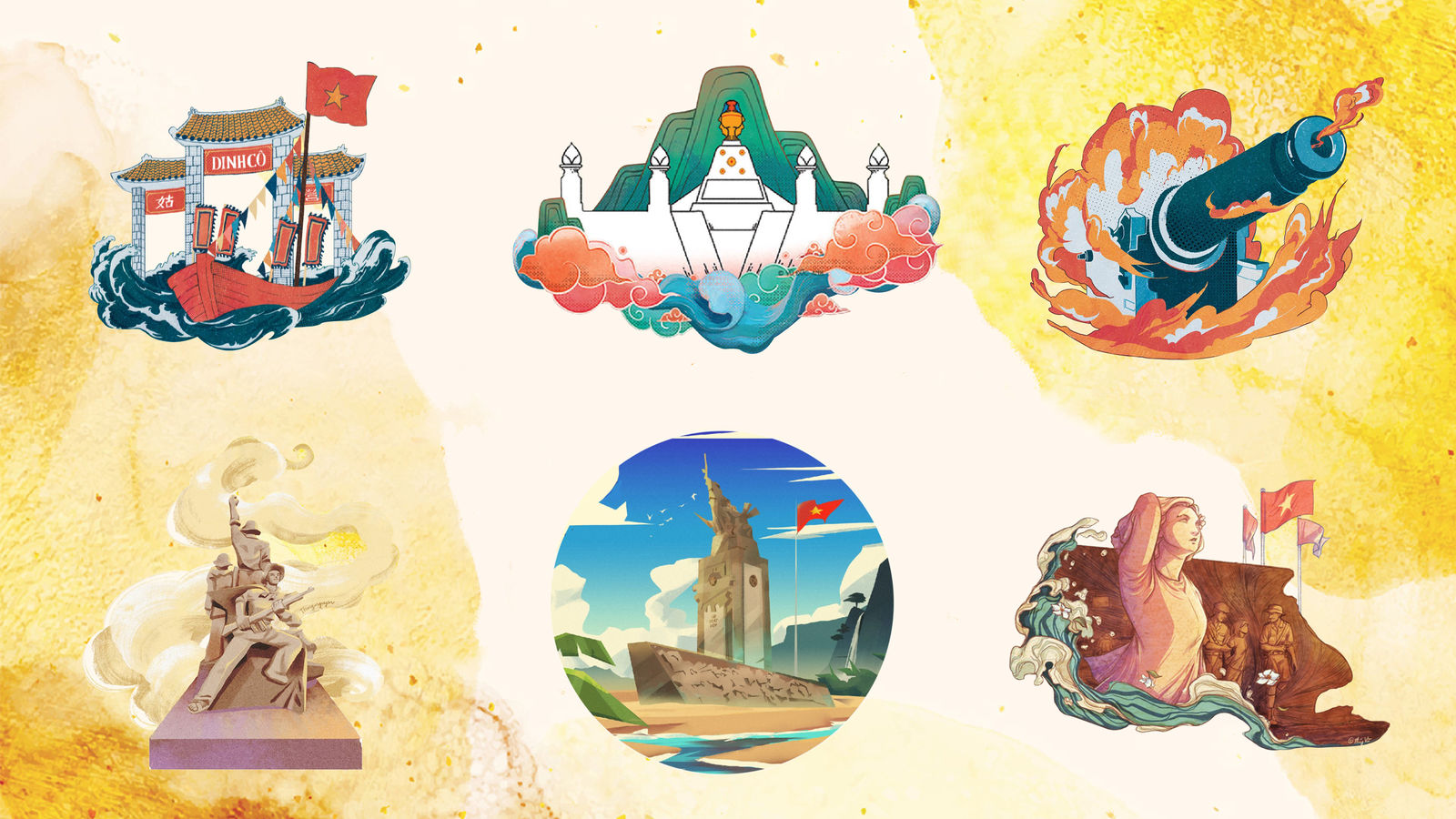“Đông Nam Bộ” is a collection of illustrations reflecting the culture, history and local charms of provinces in the Southeast Region of Vietnam. The artworks were all created by artists who live or grew up in the region.
The Southeast Region — including Bà Rịa-Vũng Tàu, Đồng Nai, Bình Dương, Bình Phước, Tây Ninh, and Saigon — is well-known on the tourist trail in southern Vietnam thanks to attractions like the Củ Chi Tunnels, Cát Tiên National Park, Bà Đen Mountain, Côn Đảo, Châu Thới Mountain, etc. Still, the area’s rich wealth of history and cultural facets are still relatively obscure among many Vietnamese, especially young people who did not grow up in the vicinity. This is what the illustration project “Đông Nam Bộ” sought to rectify.

“Đông Nam Bộ” got 14 young artists from the region together to draw their homeland.
Graphic designer Vương Quang Vinh serves as the project’s leader. Vinh is an established name in the local creative scene thanks to high-profile creations like the horror folklore collection Yêu . Ma . Quỷ . Quái, the project on Vietnamese bánh mì, or Central Vietnam delicacies. The majority of Vinh’s works delve into the vernacular culture of Vietnam.
In an email exchange with Saigoneer, Vinh shares the goal behind why he started the project: “Đông Nam Bộ is the third project in my series ‘Ký Ức Việt Nam’ [Vietnam Memories] comprising five smaller projects. The color scheme of each project corresponds with one element in the five traditional elements of Asian culture. Đông Nam Bộ is the ‘metal’ project with golden brown as its main color. Each of the relics and heritage sites chosen directly inspired our project.”
At the same time, the unifying shade of earth tones across every artwork signifies a touch of time, evoking a sense of nostalgia. Some viewers have also associated this color with the fire and debris of war, as many heritage sites are intricately linked to wartorn episodes in Vietnam’s history.

Bến Lộc An — a wharf that once was part of the “maritime Hồ Chí Minh trail” — is portrayed by artist Trúc Nhi Hoàng as an intersection of the past and the present. The present-day is depicted with cheerful, lively images showing the bustling fishing port in the moment, while the historic monument represents the port’s storied past.
Each of the participating illustrators brings their own style to interpret the prompt. As part of the project, their artwork comes with relevant information like the province name, site location, author, and most importantly, the place’s standout cultural and historical significance. The “info card” design is succinct and easily digestible for readers. Through the project, Vinh hopes to help young Vietnamese feel closer and more curious about their own historical background.
“My project facilitators and I try as much as possible not to meddle in the creative process of the 14 featured artists, so they have the freedom to draw to their heart’s content,” he shares. As locals who grew up here, the artists were eager to produce a set of inspired images showcasing the best of what their hometowns have to offer. The entire set was completed in one month.

Trampp chose a palette of white, orange, and ocean blue to paint a scene of a firing canon. The battle site and torpedo armory at Núi Lớn are both significant historical sites in southern Vietnam’s decades under French rule and Imperial Japan.
After “Đông Nam Bộ,” Vinh and his collaborators are also planning a few future initiatives. “Đông Nam Bộ was initially meant to have all six localities, but because Hồ Chí Minh City is a crucial and expansive city, we dedicated a whole part to it, gearing the content towards children. The second part of this, published in April 2021, marks the last phase of the Ký Ức Việt Nam series after two years.”
Here is the entire collection, featuring artworks by Southeast Region artists:

Artist Just a lazy Penguin chose to draw the infamous tiger cages of Côn Đảo’s prison cells, emphasizing on the cruelty of past ruling regimes.

To introduce the Chứa Chan Mountain — the region’s second-highest point — An Đặng picked a bright shade of orange to evoke a sense of majesty when the sun sets.

Rod Vũ portrays multi-colored clouds and a towering mountain range to juxtapose against the white tomb.

The distinctive turquoise roofs of the Trấn Biên Temple of Literature are replicated by Hà Thiên in this artwork. The temple was built in 1715 as the first of its kind in Đàng Trong, honoring Confucius and other Vietnamese academics.

Tân An Temple with its cluster of 200-years-old trees as depicted by Lý Triệu Vỹ.

Châu Thới Mountain is a national-level heritage site with many eye-catching elements including a pair of golden dragons and many Buddha statues. Artwork by Bình Lùm.

Cao Minh Huy wields his watercolor skills and an elegant color set to recreate a poetic Hội Khánh Pagoda on paper.

The harrowing past of this massive tomb was encapsulated by Hoài Lê in this striking imagery of a B-52 dropping bombs, turning everything on its path into an inferno.

Phan Khải Nguyên uses bright shades to depict a morning at the monument.

Of all the bases in Tây Ninh, Gò Dầu was a strategic location in our battle against American forces. This undaunting spirit was demonstrated in Thông Nguyễn’s artwork.

Duy Torao sets himself apart from other works by turning to paper cuttings to form a 3D artwork showing the Kỳ Yên Festival.

The steps to craft Trảng Bàng’s notable rice papers are shown here in Dương Hoa’s artwork.
View more illustrations from the “Đông Nam Bộ” collection on the project’s Behance page here.















